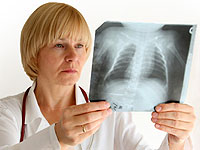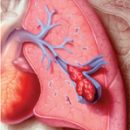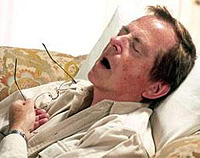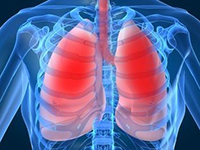Cough with wetchair, shortness of breath, constant fatigue, weakness, sweating, subfebrile temperature - all these signs of exacerbation of chronic bronchitis. Why exacerbations arise as they appear than different from acute inflammation and how to treat them.
Content
- What causes the development and aggravation of chronic bronchitis
- Symptoms of exacerbation of chronic bronchitis
- What to do with the exacerbation of chronic bronchitis
 «Chronical bronchitis — A long-lasting inflammatory disease of the bronchi, leading to deep changes to their walls, restructuring their secretory apparatus, increasing the products of bronchial mucus and disruption of the cleansing function of the respiratory tract». So about chronic bronchitis is written in the medical literature. The main manifestation of the disease is cough with a separation of some kind of sputum, and with the defeat of small bronchi — also shortness of breath caused by spasm, swelling and blocking of the respiratory tract.
«Chronical bronchitis — A long-lasting inflammatory disease of the bronchi, leading to deep changes to their walls, restructuring their secretory apparatus, increasing the products of bronchial mucus and disruption of the cleansing function of the respiratory tract». So about chronic bronchitis is written in the medical literature. The main manifestation of the disease is cough with a separation of some kind of sputum, and with the defeat of small bronchi — also shortness of breath caused by spasm, swelling and blocking of the respiratory tract.
Chronic bronchitis proceeds waving. Periods of exacerbation, during which the patient's condition deteriorates, is replaced by the periods of the clutter with residual symptoms or without it without it. In general, the picture resembles frequent colds, complicated by sharp bronchitis, but if these «Colds» Repeated often, lasts a total of more than three months a year and worried a patient for more than a year, doctors are diagnosed with chronic bronchitis.
What causes the development and aggravation of chronic bronchitis
Among the causes of chronic bronchitis and factors causing its exacerbation, in the first place there are various chemicals and mechanical impurities that are contained in the surrounding air and inhalation is irritated by the mucous membrane of the respiratory tract. The leader among provocateurs is considered tobacco smoke, tobacco lovers are sick with chronic bronchitis in 2–5 times more often than non-smoking.
Harmful impurities allocated in the air by industrial enterprises and cars are in second place. On the third — Infection, that is, viruses, bacteria, mycoplasm and fungi, in this case the chronic process in bronchi usually becomes a continuation of acute inflammation, and its exacerbation may occur without the participation of pathogenic flora.
Chronic bronchitis is equally often developing in residents of regions with a cold and warm climate, although the supercooling plays a certain role in the exacerbation of the disease.
The risk of chronic bronchitis is high in people suffering from constant nasal mortgage having chronic nasal sinus diseases, nasopharynx, pharynx and larynx.
Symptoms of exacerbation of chronic bronchitis
Cough — The main manifestation of all diseases of the respiratory tract, including bronchitis. Initially, it can dry and painful, then, as the inflammation and enhancement of bronchial mucus products develop, becomes productive, with sputum. The amount of sputum and its nature depends on the type of infection: if the aggravation is caused by viruses, the sputum is scarce, water and mucous, sometimes with blood streaks, if bacteria act as the pathogen — abundant mucoby-purulent.
As a rule, at the beginning of the aggravation of the spution, thick and moves with difficulty, mainly in the morning hours. It is then diluted and begins to flip off throughout the day, especially with physical tension, breathing and changing body position.
With the damage to small bronchi and the bronchial obstruction, the cough is a barking spastic, accompanied by swelling of the cervical veins on the breath, breath on the exhalation, the formation of the skin and mucous membranes, sometimes loss of consciousness.
The aggravation of chronic bronchitis leads to a violation of the overall state of the patient. Increases body temperature, weakness and sweating occurs. Permanent skin moisture causes a feeling of angility and makes a patient joining warm clothes, a blanket, which, in turn, predisposes to the accession of infection and the emergence of complications.
A typical sign of many years of purulent chronic bronchitis is the thickening of the final phalanx of the fingers of the hands, giving them the kind of drum sticks, and thickening nails making them similar to hourly windows.
What to do with the exacerbation of chronic bronchitis
 First of all, you need to seek medical care: the lack of competent treatment is fraught with complications, in particular the development of pneumonia, pleurite and lung abscess.
First of all, you need to seek medical care: the lack of competent treatment is fraught with complications, in particular the development of pneumonia, pleurite and lung abscess.
Treatment of chronic bronchitis, depending on the state of the patient, can be carried out at home or in the hospital, but in the hospital there are much more opportunities to facilitate the suffering and quick relief of exacerbation.
To quickly cope with the exacerbation and prevent the development of infection, the patient is prescribed antibiotics of a wide range of action and sulfonamide drugs. The duration of antibacterial therapy is different, sometimes it is stretched for several months and stops only after the signs of active inflammation in bronchi are eliminated. In the period of remission to rehabilitate the respiratory tract of patients are recommended inhalation of phytoncides.
Therapy with antibiotics is combined with the appointment of drugs acting on bronchial secretion and stimulating sputum. In some cases, there is a need to use drugs that remove the spasm of bronchi, antihistamine and desensitizing drugs and even hormones.
The above treatment is complemented by the reception of vitamins A, B, C, biostimulants, activating the protective forces of the body, therapeutic physical education and physiotherapy procedures that promote the active cleansing of bronchi and the rapid restoration of the mucous membrane.
Patients with respiratory and heart failure need oxygen therapy, prescribing heart preparations, agents that facilitate oxygen utilization by tissues.
If, through antibacterial therapy, it is impossible to stop the aggravation of chronic bronchitis, resort to the renovation of the bronchial wood by endotracheal injections and therapeutic bronchoscopy.









